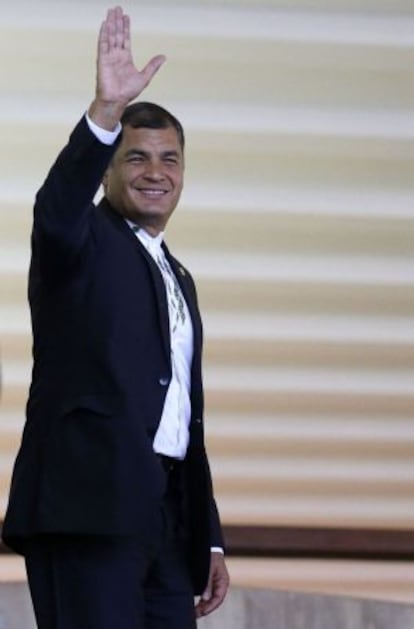Ecuador takes on debt in order to grow
In 2013, the country’s deficit exceeded $5 billion, five times more than the previous year

Oil has propped up Ecuador’s economy since the 1970s. For every $100 earned in exports, $60 come from oil sales. During Rafael Correa’s seven years as president, the price of oil has been between $80 and $100 a barrel. Still, the country has had to take on loans in order to fund public investment, which today stands at 12-13% of Gross Domestic Product (GDP). In Latin America, average public spending is 5% of GDP. In 2013, Ecuador’s deficit reached $5 billion, five times more than the previous year. And now, the government needs $4.9 billion to shore up its 2014 budget.
“The government’s great dream of investing is the cause of this fiscal deficit,” explains former minister of finance Fausto Ortiz. “The country spends because it is able to get financing and it grows because that funding is spent on public works.”
Public works are on display all around Ecuador. Connections between highways have improved notably and the government has built eight hydroelectric plants. In the Amazon, a traditionally marginalized region, the state has erected two so-called Millennium Cities, providing housing, schools, medical clinics and all that is necessary to compensate communities that have a history of living alongside oil fields. All the main buildings have modern infrastructure.
Ortiz says the country will not be able to sustain this rate of public spending. This year’s approved budget of $34.3 billion is based on the price of the barrel staying at $86.4 and it requires $4.9 billion more in funding. To make up for the shortfall, Ecuador raised $2 billion in foreign investment in June by selling 10-year treasury bonds at a yield of 7.95%. The country had refrained from taking on loans since 2008 when it declared a moratorium on a portion of its sovereign debt.Ecuador began working on the operation in May when Minister of Finance Fausto Herrera met the Inter-American Development Bank and the World Bank in Washington, D.C. The official said that together they analyzed lines of credit that could provide financing for development projects. Herrera also met the International Monetary Fund (IMF). Ecuador agreed to make regular reports to the organization, though it did not ask for financial support. The government has made an effort to emphasize its independence from the IMF. Herrera said: “The process for turning in the reports will fall within the framework of the Ecuadorian state’s sovereignty and it will not allow any interference in public policies under any circumstances.”
The government’s great dream of investing is the cause of this fiscal deficit”
Coordinating Minister for Economic Policy Patricio Rivera added: “Before, public spending went to those savage banks and now these resources increase competitiveness and productivity.” In June, it was revealed that the Central Bank of Ecuador had deposited half of its monetary reserves – 13 tons of gold – at investment bank Goldman Sachs. The excuse was that the metal was not generating any revenue in the government’s vaults. These funds have been invested at a 0.85% interest rate for three years. When the operation comes to an end in February 2017 Ecuador expects to earn between $16 million and $20 million. This investment has also served as a guarantee for Goldman Sachs’ $400 million loan to the Latin American country. Still, Ecuador must look for other investors in order for the government to raise an additional $3 billion to go toward capital payments. Ortiz says projections made at the beginning of the year predicted the current situation. According to the Ministry of Finance, Ecuador’s deficit stands at 26% of GDP. The country’s economy is worth $100 billion. Jorge Rodríguez, an economic analyst, says its capacity to support more loans is a long way from its ceiling of 40% of GDP. If Ecuador fails to raise the necessary capital, the economy may shrink. “Capital expenditure, which last year had a 12% growth rate, fell to 4% this year,” Ortiz says. “And tax revenue, which in 2013 grew by 14%, fell to 2% this year.”
Translation: Dyane Jean François
Tu suscripción se está usando en otro dispositivo
¿Quieres añadir otro usuario a tu suscripción?
Si continúas leyendo en este dispositivo, no se podrá leer en el otro.
FlechaTu suscripción se está usando en otro dispositivo y solo puedes acceder a EL PAÍS desde un dispositivo a la vez.
Si quieres compartir tu cuenta, cambia tu suscripción a la modalidad Premium, así podrás añadir otro usuario. Cada uno accederá con su propia cuenta de email, lo que os permitirá personalizar vuestra experiencia en EL PAÍS.
¿Tienes una suscripción de empresa? Accede aquí para contratar más cuentas.
En el caso de no saber quién está usando tu cuenta, te recomendamos cambiar tu contraseña aquí.
Si decides continuar compartiendo tu cuenta, este mensaje se mostrará en tu dispositivo y en el de la otra persona que está usando tu cuenta de forma indefinida, afectando a tu experiencia de lectura. Puedes consultar aquí los términos y condiciones de la suscripción digital.
Últimas noticias
From Andorra to Gibraltar, a black market for Ozempic exploits its success: ‘They’re the most sought-after products in the world’
Magnets in their heads: How some animals guide themselves using the Earth’s magnetic field
From Hungary’s Orbán to Chile’s Kast: How Trump helps turbo charge the far right
The brief rise and retreat of Generation Z in Mexico
Most viewed
- Why we lost the habit of sleeping in two segments and how that changed our sense of time
- Trump’s obsession with putting his name on everything is unprecedented in the United States
- Charles Dubouloz, mountaineering star, retires at 36 with a farewell tour inspired by Walter Bonatti
- Venezuela faces its most tense Christmas yet
- The Florida Keys tourist paradise is besieged by immigration agents: ‘We’ve never seen anything like this’








































